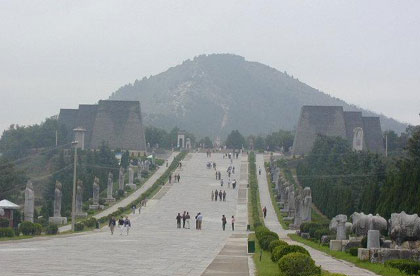TV reveals secrets of Wu Zetian tomb
By Lu Hongyan (chinadaily.com.cn)Updated: 2007-01-26 15:58
 A general view of Qianling Mausoleum where China's only ruling empress Wu Zetian was buried. [file]  |
Entitled "Under the Tablet without Characters," the programme will explore the inner structure of the mausoleum, what cultural relics it may have, the famous Tablet without Characters and 61 headless statues of leaders of ethnic minorities, foreign kings, princes and envoys, said Cao Hanmin, director of the programme.
China had 231 emperors and one ruling empress, 79 of whom were buried in Northwest China's Shaanxi Province. One imperial mausoleum in the province which appeals most to travelers is the Qianling Mausoleum where Wu Zetian and her husband Li Zhi, the third emperor of the Tang Dynasty (AD 618-907), were buried.
Wu (AD 624-705) became a lowly concubine of Li Zhi's father at the age of 14. Before Li Zhi's father died, she had an affair with Li Zhi, becoming his imperial concubine first and then empress when he ascended to the throne.
After Li Zhi died, Wu, who was known for her unrivalled beauty, wisdom and cruelty, managed to become China's only ruling empress.
Wu excelled in appointing talented people. During her 16-year reign, China enjoyed peace and stability.
Located in the Liangshan Mountain in Qianxian County, the Qianling Mausoleum and its environs look like a sleeping woman from afar.
Because of Wu's unusual experiences and great achievements, the mausoleum's unusual topographical features make it all the more mystical.
Construction of the mausoleum started in AD 683 and lasted nearly 30 years.
Now the most conspicuous relics are 103 large stone sculptures lining the passageway that leads to the mausoleum. Known as a museum of stone sculptures, they include the Tablet without Characters and the 61 headless statues of leaders of ethnic minorities, foreign kings, princes and envoys.
Dedicated to Wu, the Tablet without Characters is made of a single stone piece weighing 98.8 tons. With a height of 7.5 metres, it had no carved characters when it was erected.
Emperors liked erecting tablets with articles eulogizing their achievements.
There are two explanations about why Wu had a wordless tablet erected. One is that Wu considered her achievements were beyond the description of any high-sounding words. The other holds that Wu wanted her achievements and errors to be judged by later generations rather than herself and her courtiers.
With different costumes, positions and weapons, the 61 stone statues show the strength of the Tang Dynasty, and people from afar came to show their respect.
History books do not record why the statues lost their heads. However, a legend goes like this: the son of a statue was very unhappy to see his father standing in front of Wu's mausoleum to show respect for the late empress and came up with an idea.
One evening, he ruined the crops in the fields nearby and spread rumours that the crops were destroyed by the statues which had turned into evil spirits. Local farmers believed what he said and cut off the statues' heads.
After the collapse of the Tang Dynasty, most of its imperial mausoleums were robbed. But robbers from different dynasties tried in vain to rob the Qianling Mausoleum. When robbers started their work, it was said that there would be heavy rain, harsh wind and flying stones, which scared away the superstitious robbers, according to locals.
As the Tang Dynasty was one of the most thriving periods in Chinese history, experts believe that the archaeological find might yield what could be called the ninth wonder in the world as the Qianling Maosoleum is opened one day.
They believe the archaeological discoveries in the mausoleum might be as important as, and even more important than, that of the terra cotta warriors and horses, Cao said.
He told www.chinadaily.com.cn that the programme will also introduce murals unearthed in the 1960s from three tombs near the mausoleum, for the programme would explore the inside structure of the mausoleum on the basis of the archaeological discovery of the three tombs whose occupants were Wu's grandchildren.
Some 10 murals in the tombs of Wu's grandchildren which reproduce the scenes in which people play the polo and go out for hunting, and officials meet foreign envoys as well as depicting the honour guard of the royal family and women in the Tang court are masterpieces and represent the highest achievements of Tang paintings, said Cheng Jianzheng, curator of the Shaanxi History Museum where the murals are collected.
During their visit to the museum, former US President Bill Clinton and French President Jacques Chirac highly praised the murals. Clinton wrote that Tang tomb murals were as valuable as the terracotta warriors, he said.
|
||
|
||
|
|